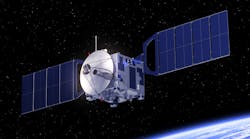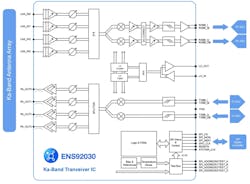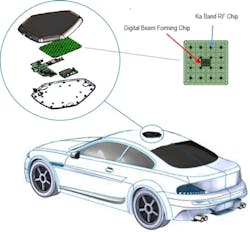Ka-band Satellites: The Key to Implementing Reliable Vehicle Connectivity
What you’ll learn:
- Why satellite needs to be used to supply reliable vehicle communications.
- What are the challenges in making it happen.
- How EnSilica tackled the problem to create a cost-effective solution.
One increasingly important factor in automotive design is the ability for the vehicle to communicate at high data rates. It’s a factor that will drive new business models in automotive as OEMs turn to subscription services and the concept of mobility as a service.
Connectivity will be vital for safety as advanced driver-assistance systems (ADAS) lead to greater autonomy for vehicles, with vehicle-to-everything (V2X) used to share information on hazards among road users. And in the short term, connectivity has become a key requirement for cars because occupants expect to be able to make calls, play games, music, and games from the comfort of their seats no matter where they’re situated.
The problem is that the conventional wide-area connectivity options on offer can’t deliver the needed levels of availability (Fig. 1).
The initial plans for V2X relied on the use of both inter-vehicle Wi-Fi and 5G cellular. But these two options are insufficient to meet the demands for constant connectivity. Even in Japan, where 4G coverage is nominally nationwide, there remain areas where radio devices can’t access a base station because they’re too remote or blocked by geographic features. The one technology that can offer coverage outdoors practically anywhere in the world is satellite communication.
The Rise of Satellite Comms
Satellite communications capacity is increasing rapidly. According to a 2020 study by McKinsey, the number of active satellites will grow to 50,000 by the end of the decade, up from just 3,000 in 2020. Though much of this growth will be for low-Earth-orbit (LEO) payloads, geostationary-Earth-orbit (GEO) satellites will remain important for communication as a way of providing full coverage in the most remote regions of the globe.
A second development that allows for the scaling of bandwidth to meet automotive demands is multibeam operation. In this mode, an array of antennas under digital control construct and steer multiple narrow RF beams in parallel to serve data at high rates to different users below. Therefore, higher-frequency satellite bands offer a considerable advantage over the S- and Ku-bands used by some existing satellite-communication services.
Operating in the 26.5- to 40-GHz range, the Ka-band makes it possible to use smaller antennas on both ground equipment and satellites than those used for the S- and Ku-bands. That, in turn, helps keep launch costs down as well as provides the ability to build orbiting equipment that can serve many users with the Ka-band’s higher-bandwidth data connections.
Beamforming
Several research initiatives have helped turn the concept of beamforming-based Ka-band communications into reality, including the Advanced Research in Telecommunications Systems (ARTES) program set up by the European Space Agency (ESA). ARTES has been instrumental in helping to create viable systems for both satellite deployment and ground vehicles.
Though beamforming has advantages in terms of potential per-user data rates, there are challenging requirements when considering the needs of moving vehicles. Typically, the roof of a vehicle provides the best location for an antenna array. It guarantees line-of-sight communication with LEO and GEO satellites whenever the vehicle is on the open road. The curvature of the roof also can improve access to LEO satellites as they near the horizon.
However, the relatively exposed location of the vehicle roof creates potential problems. The antenna and associated electronics need to be able to cope with very wide temperature ranges, from sub-zero operation to more than 60°C.
A second issue is that of vibration. The horizontal trajectory of a moving vehicle is reasonably predictable on the timescales needed to maintain connections with steerable RF beams. But vertical movement as the car drives over uneven road surfaces is large enough to affect the performance of both transmission and receive elements if not compensated.
As a result, accelerometers are needed to pass information on vehicle motion along different axes to the transceiver. Therefore, the transceiver can compensate for movements as they happen by altering reception characteristics and beamforming coefficients, ensuring it can track the satellite reliably. But this still requires an architecture where beam-control responsiveness is high.
Electronic Phased-Array Antenna Control is Best
Some research projects have suggested the use of mechanically steerable antenna elements or metamaterials, such as liquid-crystal arrays, to provide the required level of support for beamforming. These technologies don’t cope well with the requirements of the automotive environment.
Not only do liquid-crystal arrays not perform well under temperature extremes, but they also lack the responsiveness needed for handling sudden movements. Similarly, steerable antennas react too slowly to provide good performance under vibration.
An effective solution for Ka-band transmission and reception that’s aided by beamforming requires a much faster and more robust steering technique. This leads to the choice of phased-array antennas under purely electronic control.
A key advantage of using pure electronic control to steer beams is that, as the process is controlled entirely by phase cancellation and reinforcement from signals produced across an array of static antenna elements, the design can be printed at relatively low cost. The result is an antenna unit that can offer high thermal stability and environmental robustness. It also can take advantage of the curvature of the roof to maintain connections even with satellites at a low elevation.
Analog, Digital, and Hybrid Control
With this design, the key to the antenna array’s performance lies in the control electronics. Many existing electronically controlled phased-array beamforming implementations on end-user equipment rely on analog circuitry.
Analog control has the benefit of offering a relatively simple design but has the disadvantage of supporting the construction of only one steerable beam. Though the single beam can support high data rates, there will be a break in transmission and reception if the system needs to switch to a different satellite upon the primary moving out of the line of sight.
Digital or hybrid digital-analog control make it possible to maintain at least two connections at any time. This allows seamless switchover from one satellite to the other whenever the measured signal strength moves past a threshold. Users watching video or making calls will perceive no gap in service, whereas switching over with a single beam may experience delays and dropped connections.
Because hybrid control offers the best user-experience, EnSilica opted to employ the technique in the design of the ENS92030, a transceiver IC with the ability to support four receive and four transmit paths through a printed antenna (Fig. 2).
The company was able to use a bulk CMOS process rather than more exotic silicon-on-insulator or silicon-germanium manufacturing technologies to implement the transceiver. This, combined with the use of hybrid electronic control over a passive antenna, also results in low power consumption (Fig. 3). That’s a key characteristic for situations such as over-the-air (OTA) updates, where the vehicle is only running from the battery.
Now that connectivity is becoming crucial to vehicle design, manufacturers need to be able to pick solutions that ensure cars can always stay in touch with the internet. Satellite connectivity is the only way to provide this guarantee. The use of Ka-band with electronically controlled phased-array antennas delivers the best combination of data rate, cost, and power consumption to the OEM.



